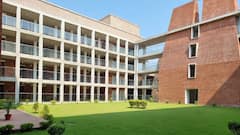Medical Education: How Global Trends Are Shaping The Future Of Healthcare Professionals
Medical education is evolving with standardised curricula, international partnerships, and advanced techs like AI and VR.

By Dr. Yashraj Patil
The field of medical education is undergoing a dynamic transformation, driven by the need to meet evolving healthcare demands and leverage technological advancements. As a leader in this field, I believe it is our responsibility to drive these changes and ensure that we are preparing healthcare professionals for the future.
Standardizing Curricula For Consistency And Quality
Efforts to standardize medical curricula globally are essential for ensuring consistency and quality in medical education. By aligning educational standards, we can produce graduates with comparable competencies and skills, regardless of their geographic location. This harmonization is crucial for facilitating global mobility of healthcare professionals and ensuring high standards of patient care worldwide.
Standardised curricula also enhance the ability of medical professionals to collaborate across borders, share best practices, and contribute to international healthcare initiatives. By adopting common educational frameworks, we can better prepare students for the challenges of global health.
Forging Partnerships With International Institutions
Collaborative partnerships with international institutions are becoming increasingly prevalent. These alliances allow us to share resources, expertise, and best practices, fostering innovation and improving educational outcomes. Joint programs and exchanges provide students with diverse learning experiences, enhancing their understanding of global health issues.
International partnerships also enable faculty development and research collaborations, further enriching the academic environment. By working together, we can address common challenges, develop innovative solutions, and contribute to the global advancement of medical education.
Telemedicine: A Key Component Of Training
Telemedicine has emerged as a critical component of medical training. The COVID-19 pandemic highlighted the importance of remote healthcare delivery, and we have adapted our medical education accordingly. Training in telemedicine equips students with the skills needed to provide effective care in a digital age, ensuring they are proficient in virtual consultations, remote monitoring, and telehealth technologies.
Integrating telemedicine into the curriculum prepares future healthcare professionals to deliver care in diverse settings, including rural and underserved areas. This trend not only expands access to healthcare but also enhances the flexibility and responsiveness of medical services.
Expanding Opportunities For Studying Abroad
Globalisation has increased opportunities for medical students to study abroad and gain diverse clinical experiences. International rotations and exchange programs expose students to different healthcare systems, cultural practices, and medical conditions. These experiences broaden their perspective, improve cultural competence, and enhance their ability to work in multicultural environments.
Studying abroad also fosters personal growth, resilience, and adaptability—qualities that are essential for successful medical practice. By immersing themselves in new environments, students develop a deeper understanding of global health challenges and learn to navigate complex healthcare landscapes.
Increased Focus On Research Opportunities
There is a growing emphasis on providing research opportunities for medical students. Engaging in research helps students develop critical thinking, problem-solving, and analytical skills. It also fosters a culture of inquiry and innovation, encouraging future healthcare professionals to contribute to medical advancements.
Research involvement enhances students' understanding of scientific methodologies, evidence-based practice, and the importance of continuous learning. By participating in research projects, students can explore their interests, contribute to knowledge generation, and prepare for academic or research-oriented careers.
Harnessing Advanced Technology In Training
The use of advanced technology, such as artificial intelligence (AI) and robotics, is revolutionizing medical education. AI-driven platforms offer personalized learning experiences, adaptive assessments, and data-driven feedback, helping students identify areas for improvement and tailor their learning paths. Robotics provides hands-on training in surgical techniques, allowing students to practice procedures with precision and safety.
Simulation technologies, including virtual reality (VR) and augmented reality (AR), offer immersive learning environments where students can practice clinical skills, visualize complex anatomical structures, and simulate patient interactions. These technologies enhance experiential learning, improve retention, and boost confidence.
As we stand on the cusp of a new era in healthcare, our commitment to these global trends in medical education will continue to shape the leaders of tomorrow. By embracing standardized curricula, fostering international partnerships, integrating telemedicine, expanding study abroad opportunities, emphasizing research, and leveraging advanced technology, we are not just preparing our students for the future—we are empowering them to lead it.
Together, we are building a future where healthcare professionals are not only well-prepared and competent but also innovative, resilient, and ready to tackle the world’s most pressing health challenges with vision and excellence. This is our mission, our responsibility, and our legacy.
(The Author is the Trustee and Treasurer of Dr. D. Y. Patil Vidyapeeth (Deemed to be University), Pimpri, Pune)
[Disclaimer: The opinions, beliefs, and views expressed by the various authors and forum participants on this website are personal and do not reflect the opinions, beliefs, and views of ABP News Network Pvt Ltd.]
Education Loan Information:
Calculate Education Loan EMI
Trending News
Top Headlines






































